Fifty years ago a collection of shearers,labourers and footballers boarded a plane at Mascot airport for rugby league’s version of cricket’s fabled of England.
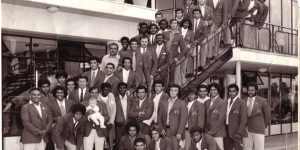
The 1973 Indigenous All Stars team at Mascot airport ahead of their historic trip to New Zealand.Victor Wright snr
Unlike their cricketing counterparts,the 1973 Aboriginal All Stars went largely sight unseen in wider rugby league circles,both at the time of their landmark tour to New Zealand and in the decades since.
Until now.
Half a century after being emphatically denied the chance to wear green and gold by the ARL,and offered just $190 in tour funding by the governing body,the original Indigenous All Stars will finally have the red carpet rolled out for them.
“Not being able to wear green and gold back then,that hurt like nothing else,” Ron Mason,one of the touring All Stars captains and an icon of south coast rugby league,says.
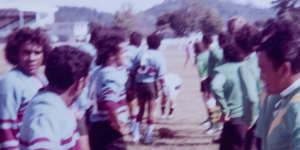
The 1973 Indigenous All Stars face up to their Kiwi opponents.Victor Wright snr
“There was a lot of racism in footy back then of course so we shouldn’t have been that surprised,but we went and represented our people. And the memories and bond of that tour still stick with all of us today.”
Surviving members and families of the touring party — which included famous names like Mundine,Tallis and Widders — will finally be presented with commemorative green and gold jerseys this year.
Thirteen players and officials able to travel will be feted in Rotorua during All Stars week,joining the current side as the NRL rolls out long-overdue acknowledgment for one of the most significant teams in Indigenous rugby league history.

‘More recognition in New Zealand than we did in our own country’
Conceived during the early days of the Koori Knockout competition,Indigenous officials began plotting a 10-day,nine-game tour from Auckland to Christchurch in late 1972.
They did so with little help from rugby league’s top brass,and active opposition when it came to wearing traditional colours,largely because the ARL was not involved in selecting the sides.
“The ARL didn’t want a bar of it,there was no way we were going to be wearing the national colours on their watch,” Dr Bob Morgan OAM,one of the tour managers,says.
“Of course,you couldn’t get more Australian than this mob,could you? They offered us $190 as an afterthought,which was sad because this was the equivalent of the first Indigenous cricket tour 100 years earlier.”
‘Most of the boys were terrified on that plane,let me tell you.’
Bob Morgan
Famed Indigenous activist Charlie Perkins is lauded by surviving players as the “angel of a man” who helped secure $14,000 in funding for the tour through the National Aboriginal Sports Foundation.
Probables v Possibles matches were played up and down Queensland and NSW,with the sky blue and maroon eventually paired as the colours of the tourists’ uniform at the suggestion of TV pundit and dual international Rex Mossop.
“Just like the 1908 Australian team,of course,even though we weren’t allowed to wear the green and gold,” prop Victor Wright jnr chuckles.
With Rabbitohs and Indigenous legend Eric Simms helping to pick the side and a 30-strong playing contingent featuring two players from the Northern Territory,and the wider touring party including a baby relative of tour manager Douggie Scott,the Aboriginal All Stars took flight.
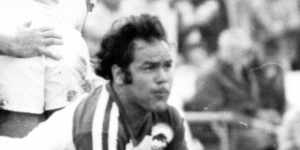
Terry Wickey clears a scrum for Penrith in 1979,with Arthur Beetson watching on.Fairfax Media
“And most of the boys were terrified on that plane,let me tell you,” Morgan laughs.
“No one had passports back then so it helped that we were travelling in a big group,but that’s just how it was for a lot of fellas back then. Rugby league opened a lot of doors for people,and at that time we found much more recognition in New Zealand than we did in our own country.”
With players like Mason (Panthers),Bruce Stewart (Roosters) and Wally Tallis,father of Queensland’s Gorden,joined by future first-graders Ambrose Morgan and Thomas Moylan (Rabbitohs) and Terry Wickey (Panthers and Raiders),the tourists’ top side was competitive to say the least.
Kiwi audiences remain stunned that flying winger Mickey Mundine — uncle to Anthony — never played first grade. He still can’t quite believe the size of his Maori opponents.
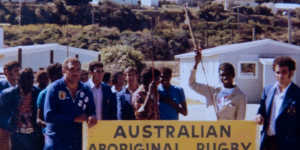
The All Stars team touches down in New Zealand.Victor Wright snr
“One leg on them would be twice the size of both of mine!”
The Indigenous players remember their team bus being greeted by massive crowds as they covered more than 12,000 kilometres,traditional hangis and cultural receptions wherever they went.
In return,the tourists’ own troupe of traditional dancers from the Northern Territory would offer their own rain dances in response to thundering hakas from the locals.
“They’d been in drought all summer,so when it rained straight afterwards,those boys were the most popular people in the country,” Wright says.

“There was so much rain in Rotorua that the roads were completely flooded,and we had to go the long way around.”
Dean Widders grew up with stories of the tour from his uncle Bill,and points to the formation of all-Indigenous teams like the Moree Boomerangs off the back of the 1973 pioneers.
“Rugby league has always led the way for Indigenous people and been part of our identity,” Widders says.
Months of painstaking research by the NRL’s Alanah Scholes and Corey Rosser and subsequent ringarounds have reconnected old teammates,unearthed forgotten photos and documents and helped bridge a gap that was allowed to widen for decades.
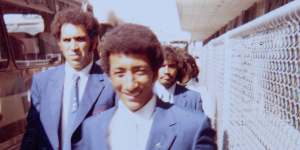
Aboriginal All Stars Don Carter and Victor Wright jnr (right).Victor Wright snr
“Rugby league was a way for our mob to leave the reserves and missions,playing the game offered freedom of movement at the time,” Scholes says as both the daughter of Victor Wright and the NRL’s Reconciliation Action Plan manager.
“The history of the game and our people,rugby league brought people together and allowed us to be treated as people.
“This team wanted to represent their country and wear those colours proudly. Unfortunately they weren’t able to,so it’s important we acknowledge them.”
For Morgan and the players still around,the long-overdue recognition means the world.
“It’s a little bit like the in 2008,” Morgan says. “We can’t change the past,but it’s important to learn from it and this team helped change rugby league and life in general for Indigenous people in this country.”
Sports news,results and expert commentary..